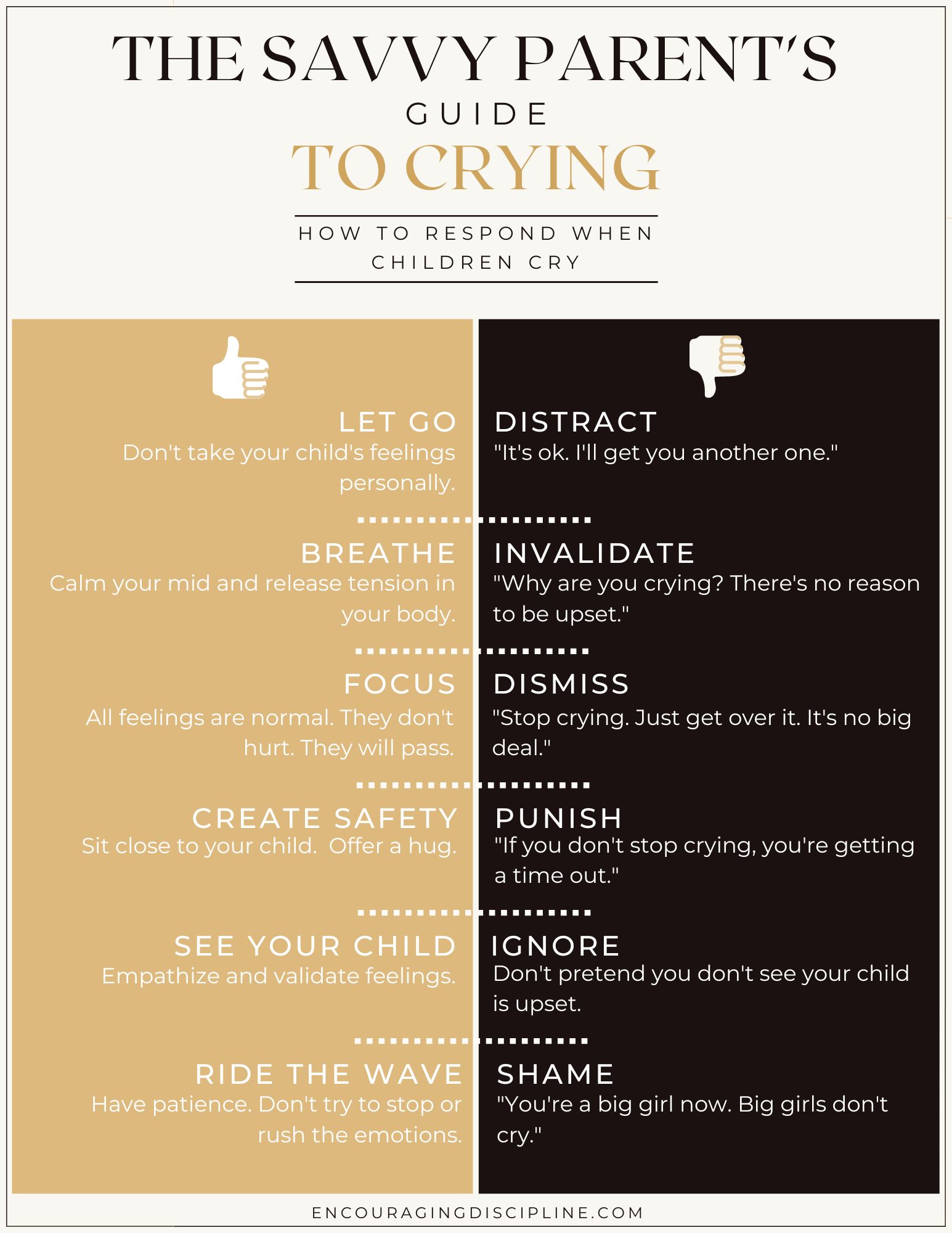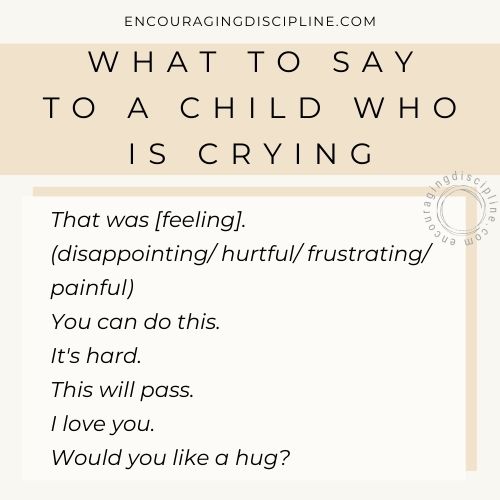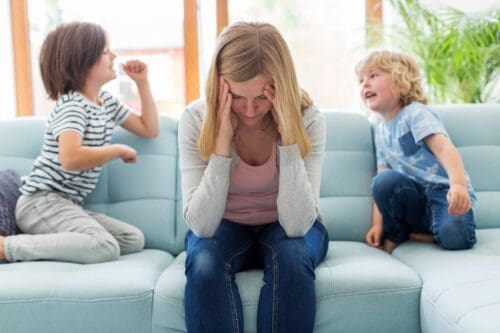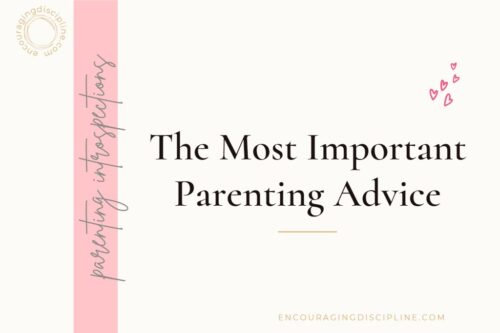How to Respond When Children Cry
Hearing our children cry or watching them being disappointed or suffering is heart-wrenching. It can be very triggering and we can have reactions that are disguised as helpful, but they can cause more harm. Learn how to respond when children cry and what not to say and do to avoid making things worse.
Key Points
► When we distract, invalidate, dismiss, ignore, punish, or shame our children’s emotions, they learn to numb them.
► Feelings are important for our safety and we express them to communicate our needs and to release them.
► When we respond to our children’s crying, it is important to detach, calm ourselves, and focus on the child’s experience by creating safety, empathizing, and validating their experience. Then giving the feelings time to pass.
►To help children cope with unpleasant feelings, we can teach them emotional skills and focus on building a healthy attachment.
Table of Contents
Do We Want Our Kids to Be Always Happy?
We all want our children to be happy. Understandably, we don’t want our children to suffer. But what do we mean when we think of “happy”?
When I ask parents what they mean by “happy”, they talk about feeling confident, loved, secure, resilient, and knowing one’s own worth. And that’s fine!
But when our children are young, in our day-to-day lives, we tend to equate “happy” with being constantly positive, cooperative, excited, jolly, and generally in a good mood. In other words, we expect only feelings that are comfortable and pleasant.
We don’t think unpleasant feelings and tears have a place in “happy”. We don’t like our children to display emotions such as disappointment, frustration, disgust, sadness, anger, shyness, irritability, anxiety, and the list could go on and on.
We Share Negative Feelings With Safe People
Even adults have unpleasant feelings all the time. And who do we go to when we have those feelings? Who do we feel comfortable sharing them with? We only show these feelings to people we feel safe with, people who we know will not judge us for having these emotions, will allow us to pour them out, and not jump in with solutions.
So why don’t we allow our children to show us their full range of human emotions?
Shouldn’t we want to be that safe person for our children? Would we not want them to know that they can come to us and show us how they feel and that we will be there for them to listen and hold their tender hearts without judgment?
I think all parents would want their children to come to them when they need emotional support.
But this is a tough job. Crying is very triggering for many parents and it causes a lot of anxiety. We haven’t been taught how to respond when others cry.
Not to worry though, we can train for it.
We can begin by identifying the unhelpful reactions that we tend to have when children express uncomfortable emotions and replacing them with ones that are supportive.
Unhelpful Reactions to “Negative” Emotions
How do we generally respond when our children cry or display undesirable feelings?
- Distract: “It’s ok, I’ll get you another [toy].”
- Invalidate: “That’s nothing to cry about.”, “Why are you so upset about this?”
- Dismiss: “Just get over it. It’s no big deal.”
- Shame: “You’re a big girl now. Big girls don’t cry.”
- Ignore: this one is pretty clear. We simply leave the child to deal with his own emotions or pretend we don’t see something’s wrong.
- Punish: children get sent to timeout or “given a reason to cry about”.
- Rush: trying to get the child to calm down to “feel better”.
Some reactions are disguised as helpful when they actually aren’t. “Let’s just take a few deep breaths. You’ll feel happy again soon.” We rush the child to get through the feeling. And we subtly suggest the unpleasant feeling is something we want to get rid of quickly in order to get to more desirable feelings.
While taking deep breaths is very helpful to get through tough emotions, we should do so mindfully. I would make sure to leave out the part suggesting the child should feel happier or better soon.
Our Children Form Negative Beliefs
What all of these reactions have in common is that they communicate to our child some or all of the following:
- I am wrong for having these feelings.
- My reality is wrong.
- I am bothering my parents.
- My feelings are unimportant or unfounded.
- No one understands me.
- No one cares about how I feel.
- I am not accepted.
Of course, we don’t mean to send these messages. But this is what children understand when we distract, dismiss, invalidate, shame, ignore, punish, or rush them when they have big feelings.
At the end of the day, our reactions to our children’s crying truly are all about us. We don’t allow children to express their nasty feelings because they make us feel uncomfortable.
A Note About Distracting From Feelings:
When we distract our child from unpleasant feelings, we may stop the expression of the emotion, but not the emotion itself. The emotion will remain stuck in our child’s body, waiting for another opportunity to come out.
The only times that I agree with distracting a distressed child is either when they are exhausted and just need to rest pronto, or when we are in a public place, with no chance of escaping. For instance, we are in line at the store and our child is about to pierce everyone’s eardrums. In this case, it would be okay to buy some time and postpone the expression of big feelings for when we are in the car or at home, where our child can go safely and privately through the emotion.
Related: How to Deal With Tantrums
The Numbing Effect of Rejecting Strong Feelings
As a society, we tend to sort through our children’s emotions and want to clean them up.
However, what happens when we don’t allow children to express all their emotions is that they begin to develop emotional defenses against vulnerable feelings. Neuroscientists call this emotional inhibition. In other words, children are learning to stuff their emotions, to not pay attention to them. Eventually, after they do this for a while, they have a hard time identifying all their emotions.
The problem with numbing emotions is that it’s not a selective process. We can’t prevent ourselves from feeling some emotions that we don’t like and only feel those that we do like. It doesn’t work that way. If we suppress emotions, then it’s all of them. We don’t feel the unpleasant ones, and we don’t feel the pleasant ones either.
Of course, this is not healthy.
The Importance of Having Feelings
Feelings have an important role. They tell us to stay away from things that could harm us and to approach things that are good for us.
When someone stops being aware of their emotions, they are no longer able to gauge danger (by feeling alarmed and unsafe). Another example is that they can’t choose friends based on who is a good fit for them. And they also become less adaptable.
The Importance of Expressing Feelings
All expressions of emotions serve two purposes. One is communication and the other one is release – to help the emotion travel through and leave the body.
Expressing Feelings Is Communication
Through expressions of feelings we connect with other people, we signal that we need help, or that we want something to change.
Think of when your child was a baby. Crying was your baby’s way of letting you know that they needed feeding, a diaper change, they were overwhelmed, or something was bothering them.
Once children begin using words, they resort to tantrums and screaming may be accompanied by kicking and hitting.
Modern culture will have us think that tantrums are a phase that we had better ignore or punish lest our children learn to use tantrums or crying to manipulate us. In reality, responding to tantrums compassionately (or rather, listening to tantrums) is what will make the tantrums eventually go away, without leaving any traces behind.
When children are verbal, we expect them to begin expressing and managing their emotions the same way that we do. But they don’t have the skills yet. Language develops before the ability to manage emotions.
If we do not allow children to express all their emotions, we “[prevent] them from exploring the full range of their individual capabilities.”
– Stephanie Coontz
Here Is How to Respond to Crying
First off, we need to start listening to all the feelings that our children are expressing. Not just the ones that don’t make us feel uncomfortable.
The most important words to remember are:
- Comfort – offer hug, proximity
- Empathize – soft face, kind words
- Validate – show understanding
- Wait – stay patient

What to Do When Children Cry
1. Let go
Don’t take it personally. Your child’s feelings have nothing to do with you and they are not your responsibility. Their feelings are their own response to a given situation.
2. Breathe
We need to be relaxed, not overwhelmed by our own emotions. Breathing creates space inside ourselves to receive our child’s feelings.
It is normal for our body to tense up when our child is suffering. But our children sense our tension. And we cannot connect with them if we are tense.
3. Focus on grounding truths:
- All feelings are normal. Your child is not wrong for having them.
- If allowed, all feelings are temporary and will pass.
- Feelings can’t hurt my child, even if they feel very painful or look bad.
4. Create safety
Go in close and give your child a sense of safety. Offer a hug. Touch their shoulder or foot. Caress their head.
5. See your child
Tune in to what your child is feeling. Empathize and validate their emotions.
6. Ride the wave
Wait patiently. Don’t try to stop or rush the emotions. Allow your child as much time as needed to feel the emotions.
What to Say When Children Cry
In a low, calm, warm, loving voice, you can say some of the following empathetic statements:
- “It is hard.”
- ”You can do this.”
- “I love you.”
- “It will pass.”
- Restate the feeling: “That was disappointing.”
- “Would you like a hug?”
Use only a few words, mainly body language. This is not about you, it’s about your child and all you have to do is show loving support and hold space for them to go through this emotional tunnel and come out the other way.

The messages we want to convey are:
- It is normal to feel this way.
- You will be ok even though it feels really hard right now.
- I am here for you and I will be with you through your (fill in emotion).
- You are lovable even when things are hard for you.
When children feel accepted, respected, and safe, they will open up to us.
In fact, the next time your child is having a meltdown in your presence, it means they are feeling safe and close to you, so they’re letting you into their most intimate and vulnerable part of themselves.
Preventive Care
1. Teach emotional skills
When your child is calm, on a regular basis, teach them to name emotions and put into words how they’re feeling. Also explain to your child that all feelings come and go, like the waves.
2. Coping strategies
Together, come up with strategies for coping with big feelings. The strategies can be useful to make the feelings more bearable while allowing them to take their course.
3. Build a healthy attachment
Children have to know we are on their side, and that they are not alone. This means that we do not overreact when they make mistakes or when they need to share their feelings.
Related: How to Get Better Behavior With Special Time
Final Thoughts
When we allow our children to express their emotions and we respond with warmth and acceptance, we support their emotional development. Children will learn to self-regulate and will develop emotional intelligence.
Children who understand their own emotions also recognize them in others and know how to respond to them.
Our job isn’t to create a tough environment for our children to “prepare them for the real world”. Instead, we should help our children to become resilient, to know that they can fall down and get back up again, and that they have a safe space to lean on when they need it.
I hope that, after reading this, you feel more confident in knowing how to respond when children cry.







